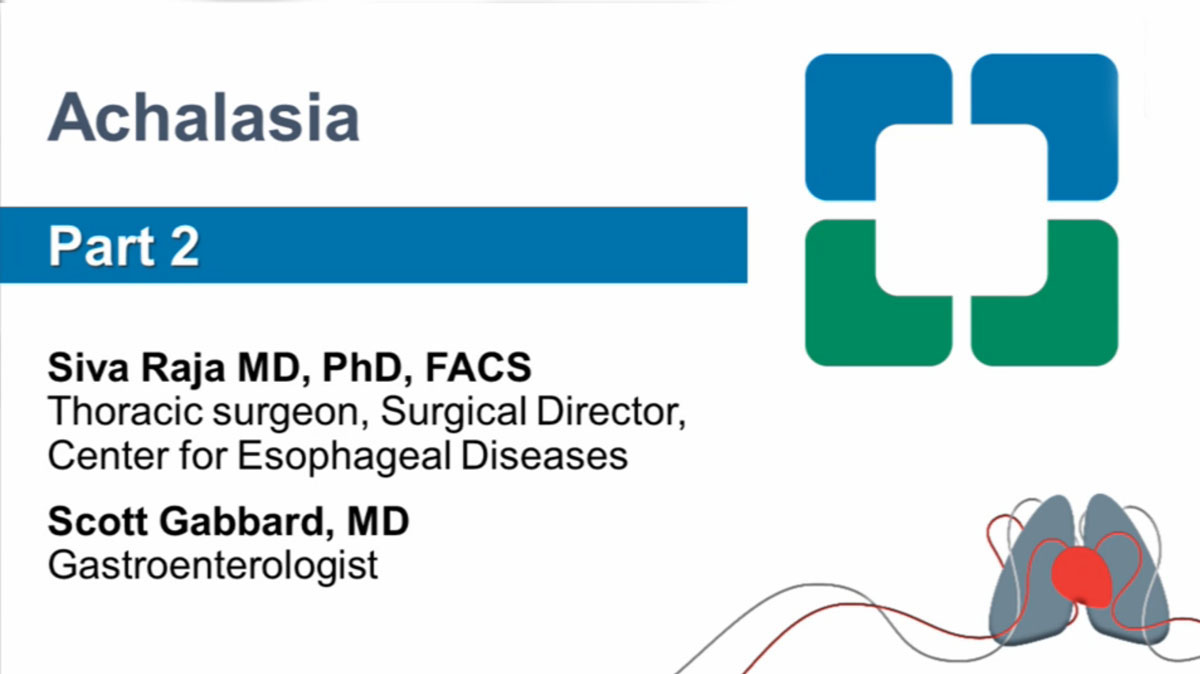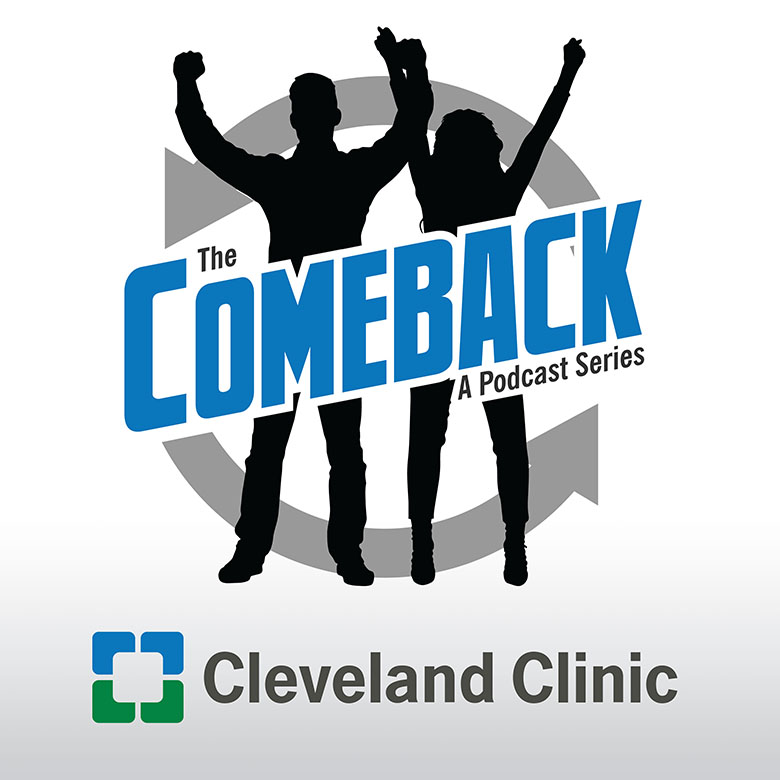Achalasia Part 2

In this three part program, achalasia experts thoracic surgeon Dr. Siva Raja and gastroenterologist Dr. Scott Gabbard answer all the questions commonly asked by patients with symptoms of achalasia, going through diagnostic testing or being treated for achalasia.
Achalasia Part 2
How do people feel after surgery?
Who should get what procedure?
Are types of achalasia related to treatment
Are you at risk for cancer if you have achalasia?
Other episodes:
What is it?
How is it diagnosed?
What are the symptoms?
What are the treatments?
How is recovery?
What is involved in long term treatment of achalasia?
What happens if your symptoms occur again after you have had surgery?
What are the outcomes of treatments?
Subscribe: Apple Podcasts | Podcast Addict | Buzzsprout | Spotify
Achalasia Part 2
Podcast Transcript
Announcer: Welcome to Love Your Heart brought to you by Cleveland Clinic's Sydell and Arnold Miller Family Heart and Vascular Institute. These podcasts will help you learn more about your heart, thoracic and vascular systems, ways to stay healthy and information about diseases and treatment options. Enjoy.
Dr. Raja: We're going to take a minute to talk about how these people do after these operations, just to get a sense of what's involved and what it takes to do these procedures. I think that in the world of minimal invasive surgery, having an operation that takes about an hour to do, and it takes about a day in the hospital at most, then go home, and that's what the majority of people have. And within a couple of weeks you're recovered from the robotic surgery and if we do the endoscopic operation, it's what they call the incisionless surgery or there's no holes anywhere in the belly. Then if you have it done on a Friday which is what we tend to do most days, and by Monday, you're back to your old self. Hopefully with much better eating situation.
And so far one of the things that we've done is that it's not enough to just do the operation, but we also do follow patients for a long time. So we actually have a sense of how people do and we've been following patients now for well over 10 years and some people up to 15 years, and we know that for long term, most people are doing pretty well. And I think that's the importance, is treating people with achalasia is not just taking care of the problem but making sure that they're doing well long term and the problem doesn't come back.
One of the things we are going to talk about is very briefly is who gets what. What are your thoughts on who should get what procedure? As you said we don't want to be the person that has one hammer in our tool box so that everything you look at looks like a nail, right? So we want to see who do you think in your mind should be getting the Botox or the POEM or a myotomy or pneumatic dilation.
Dr. Gabbard: Yeah, it's a great question and I think what's really nice about our treatment approach is when we have patients come for achalasia we make sure they talk and get the gastroenterologist perspective, they get the surgical perspective, we give them the education and allow them to decide what treatment works best for them.
All things being equal, for someone who's young and healthy, I find myself leaning towards sending a patient for a laparoscopic heller myotomy for the reasons Dr. Raja just said. It really works well, 85, 90 percent efficacy in helping the swallowing, but it cuts that rate of reflux down to 10 to 15 percent, which is quite good. The POEM surgery has similar efficacy for difficulty swallowing, but the reflux rates have been reported 50 plus percent, so those patients may end up needing to be on lifelong acid reflux therapy.
So we really individualize it to the patient and the type of achalasia they have which we didn't mention prior, but there're a couple different types of achalasia. Do you want to talk about the surgical approach for the different types?
Dr. Raja: Yeah sure. There are three types of achalasia at the moment that is based on certain criteria that come up with. There's type 1 achalasia, which is that even though your esophagus or your food pipe does not squeeze in an organized fashion, it can sometimes squeeze all at once. So when it has that ability to squeeze but very few of the time, then we call it type 1 achalasia. And these are folks that tend to rely more on gravity to help their food go down rather than the pressure in the esophagus.
When the esophagus or the food pipe can squeeze the food down a little bit more, even in a disorganized fashion, then we call that type 2 achalasia. And these two are thought to be along the same spectrum.
But you have type 3 achalasia, which is the extreme on the other side, which is these disorganized contractions are very, very strong. And these are the folks that often have a lot of chest pain associated with it and historically the treatment, the heller myotomy has not always been great at relieving the chest pain.
So we actually customize our treatment based on what they have. So for type 1 achalasia, and people for whom the esophagus or the food pipe is not very stretched out, we tend to, for type 2 achalasia and type 1 where it's not stretched out, we do the heller myotomy.
The POEM is a pretty good option for patients who have the type 3 achalasia, because we can cut more of the muscle in the chest and that actually helps decrease their chest pain as well as let the food go down easier.
And then of course there are folks they had prevous operations. Someone's already had a heller myotomy so going back in surgically is more challenging. These are perfect patients who benefit from a POEM procedure where you have known you can go someone else where the previous operation wasn't in, there're no incisions, there's no scar. So that's a great option for them.
And of course there's an area where people, if they one reason or the other want one or the other, we usually have the discussion with them giving people the advantages and disadvantages of each. And then based on what people want, we make a decision together as to what we should do.
Along the lines of achalasia, Dr. Gabbard and I have been doing these web chats every six months for several years now and every day we get a lot of new questions but sometimes we get the same question. So one of the questions I want to bring up here and I want to hear your answer on this, is that a lot of people have a lot of concern about achalasia and their risk of developing cancer, either from the achalasia or from maybe the reflux afterwards. What are your thoughts?
Dr. Gabbard: It's a great question. I think most studies have shown that the risk of developing cancer with achalasia is low but higher than it is for the general population. Some of the thought behind that is with time, if you have food liquid sitting in the esophagus, over time that causes a lot of inflammation high up in the esophagus. And they can get a cancer that we don't often see here called squamous cell carcinoma. So in my achalasia patients I will generally offer them a scope every three to five years even if they're feeling well to make sure we're not missing any pre-cancerous changes. It's not part of any standardized guidelines but when we talk to our esophageal experts around the country, most esophageal experts are doing this scope every three to five years even in patients who feel well after surgery for achalasia, to make sure they don't have any pre-cancerous changes.
Dr. Raja: But in general if I had achalasia, how worried should I be that I'm going to get cancer?
Dr. Gabbard: The rough estimate is about 1 in 500 per year, so it's pretty rare but it's common enough that we like to scope our patients very three to five years and make sure they don't develop any.
Announcer: Thank you for listening. We hope you enjoyed the podcast. We welcome your comments and feedback. Please contact us at heart@ccf.org. Like what you heard? Please subscribe and share the link on iTunes.

Love Your Heart
A Cleveland Clinic podcast to help you learn more about heart and vascular disease and conditions affecting your chest. We explore prevention, diagnostic tests, medical and surgical treatments, new innovations and more.


